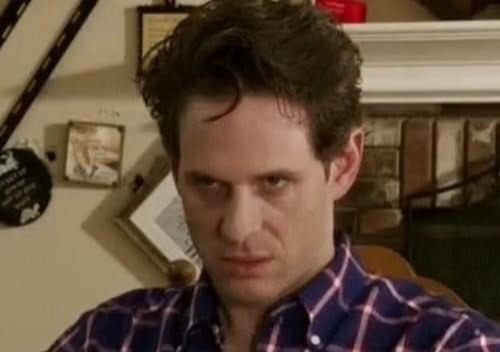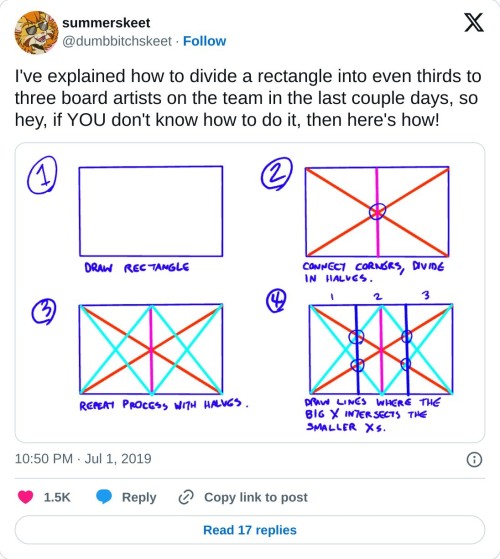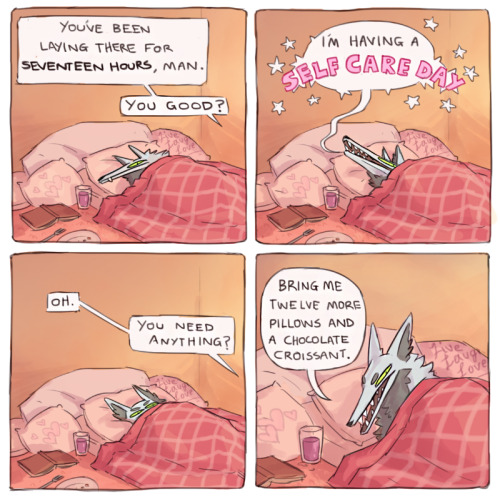Via Indiarosecrawford
via indiarosecrawford
Frog Paints a Water Lily Pond 🪷🎨🐸
𝑓ₒᵣ ⲕᵢ𝑛𝑔 ₐ𝑛𝑑 𝑐ₒ𝑡𝑡ₐ𝑔ₑ
More Posts from Kangaroomaze and Others
this is why he has a lifejacket, they were obligated to let him swim for the olympics

video inspiration below the cut


Uh
Baby (pickled)
in almost every other children's book where the main heroine is swept away to a land of whimsy she's shown having a lovely time; braving dangers occasionally, trying to find her way home, sure, but ultimately delighting in the magic around her. meanwhile alice spends her entire time in wonderland like


really helpful technique ^ once you know how to divide by halves and thirds it makes drawing evenly spaced things in perspective waaay easier:



cowgirl Gangle... save us cowgirl Gangle... or like gummyelephantgirl? (plus some extra mini gangles)


awooga
A silly animatic of my ocs.

it’s just one of those croissant days
Video essay by Jellybox about what's good and bad about indie animation!
Wanted to share this in case it's helpful to anyone wanting to pursue making animation independently. It's also for fans of indie animation who may want some insight into how an indie studio works, why indie cartoons are always selling merch, why release schedules are often erratic, etc.
I also wanted to clarify the video's context, because it seems to have been somewhat misconstrued in some circles. Not long ago, WGA and SAG strikes, followed by TAG negotiations were very much in the news, shining light on the struggles the artists, writers, and actors in the Hollywood studio system are facing. In response, the words 'just go indie' have been tossed around quite a bit lately.
Gene and Sean at Jellybox approached us a few months back explaining that they were planning to make a video about the realities of running an indie studio/producing indie animation, largely in response to that 'just go indie' attitude. They were curious if we'd be willing to share our experience, including information about actual costs and the various difficulties and complications we've encountered. We said yes! We'd like for people to know what it's like. As much as it might look appealing next to the currently very broken studio system, indie has its own set of problems, and we think it's a good idea to be transparent about that because talking about problems is how you begin to address them.
Of course, while you get creative freedom and you have no shareholders to appease with indie production, the primary struggle you're always going to face is funding…and funding avenues are limited. Banks aren't eager to hand out business loans to freelance artists making cartoons, for instance. Social media algorithms reward frequent updates you can't swing with hand-drawn animated content, so you can't rely much on things like AdSense. You can't really insert sponsored ads into your animated videos without being too obtrusive. You can take on client work, but that interferes with your ability to focus on own animated project. Crowdfunds can be great for seed money, but they're also a ton of work to fulfill, and fulfillment itself will tend to eat up a considerable amount of the funds you've raised. Once your animation is produced, there is no well established way to sell the animated episode itself like there is for, say indie games sold on Steam. So, while we consider ways to try to make the terrain a bit more hospitable to indie creations, if nothing else, let this explain why productions rely a lot on merch drops!
-----------------
And hey, if you're an animation fan, consider supporting the independent productions you enjoy, whether you're tossing a few dollars their way, buying their merch, or just mentioning them to friends:
The Far-Fetched team is launching a crowdfund very soon to help them complete their pilot!

The Monkey Wrench team is killing it lately, and they deserve so much more fanfare than they've gotten!

And of course, thank you to the excellent folks at Jellybox for starting an important conversation!


Gangle AU 🎭✨️

Fetti's human rights get tested.
-
 gloktavision reblogged this · 1 week ago
gloktavision reblogged this · 1 week ago -
 anomymous2 reblogged this · 1 week ago
anomymous2 reblogged this · 1 week ago -
 anomymous2 liked this · 1 week ago
anomymous2 liked this · 1 week ago -
 rachelle-on-the-run reblogged this · 1 week ago
rachelle-on-the-run reblogged this · 1 week ago -
 tookawrongturnandjustkeptgoing reblogged this · 1 week ago
tookawrongturnandjustkeptgoing reblogged this · 1 week ago -
 onceuponawhine reblogged this · 1 week ago
onceuponawhine reblogged this · 1 week ago -
 idlebirdsparagon reblogged this · 1 week ago
idlebirdsparagon reblogged this · 1 week ago -
 screaming-alone reblogged this · 1 week ago
screaming-alone reblogged this · 1 week ago -
 presentablypunk reblogged this · 1 week ago
presentablypunk reblogged this · 1 week ago -
 presentablypunk liked this · 1 week ago
presentablypunk liked this · 1 week ago -
 pistachioinfernal reblogged this · 1 week ago
pistachioinfernal reblogged this · 1 week ago -
 pistachioinfernal liked this · 1 week ago
pistachioinfernal liked this · 1 week ago -
 scenerwiththegreenery reblogged this · 1 week ago
scenerwiththegreenery reblogged this · 1 week ago -
 unfortunately-unoriginal reblogged this · 1 week ago
unfortunately-unoriginal reblogged this · 1 week ago -
 trashcat-x reblogged this · 1 week ago
trashcat-x reblogged this · 1 week ago -
 jestembabe liked this · 1 week ago
jestembabe liked this · 1 week ago -
 jestembabe reblogged this · 1 week ago
jestembabe reblogged this · 1 week ago -
 optionalwarninglabels reblogged this · 1 week ago
optionalwarninglabels reblogged this · 1 week ago -
 choulii liked this · 1 week ago
choulii liked this · 1 week ago -
 epicmusic42 reblogged this · 1 week ago
epicmusic42 reblogged this · 1 week ago -
 epicmusic42 liked this · 1 week ago
epicmusic42 liked this · 1 week ago -
 newfiemunky liked this · 1 week ago
newfiemunky liked this · 1 week ago -
 gayestinallthelandagain reblogged this · 1 week ago
gayestinallthelandagain reblogged this · 1 week ago -
 gayestinallthelandagain liked this · 1 week ago
gayestinallthelandagain liked this · 1 week ago -
 spotted-owl reblogged this · 1 week ago
spotted-owl reblogged this · 1 week ago -
 graciecatfamilyband liked this · 1 week ago
graciecatfamilyband liked this · 1 week ago -
 hes-all-and-hes-more reblogged this · 1 week ago
hes-all-and-hes-more reblogged this · 1 week ago -
 wastedwaterpotential reblogged this · 1 week ago
wastedwaterpotential reblogged this · 1 week ago -
 ryehouses reblogged this · 1 week ago
ryehouses reblogged this · 1 week ago -
 clearblazedaze reblogged this · 1 week ago
clearblazedaze reblogged this · 1 week ago -
 de-cleyre liked this · 1 week ago
de-cleyre liked this · 1 week ago -
 aldebaran-k5iii liked this · 1 week ago
aldebaran-k5iii liked this · 1 week ago -
 rowseofteeth liked this · 1 week ago
rowseofteeth liked this · 1 week ago -
 gatheringofmushrooms reblogged this · 1 week ago
gatheringofmushrooms reblogged this · 1 week ago -
 sefuckstianstan reblogged this · 1 week ago
sefuckstianstan reblogged this · 1 week ago -
 minakokita liked this · 1 week ago
minakokita liked this · 1 week ago -
 denynnn reblogged this · 1 week ago
denynnn reblogged this · 1 week ago -
 in-the-dawning-sky liked this · 1 week ago
in-the-dawning-sky liked this · 1 week ago -
 schwarzbewithyou88 liked this · 1 week ago
schwarzbewithyou88 liked this · 1 week ago -
 owlsreblogs reblogged this · 1 week ago
owlsreblogs reblogged this · 1 week ago -
 androreblogs reblogged this · 1 week ago
androreblogs reblogged this · 1 week ago -
 randomturnip liked this · 1 week ago
randomturnip liked this · 1 week ago -
 bonkofamerica liked this · 1 week ago
bonkofamerica liked this · 1 week ago -
 romanreportage reblogged this · 1 week ago
romanreportage reblogged this · 1 week ago -
 romanreportage liked this · 1 week ago
romanreportage liked this · 1 week ago -
 nefretitties reblogged this · 1 week ago
nefretitties reblogged this · 1 week ago -
 eight-rounds-to-ping liked this · 2 weeks ago
eight-rounds-to-ping liked this · 2 weeks ago -
 marshall-ned liked this · 2 weeks ago
marshall-ned liked this · 2 weeks ago -
 tvmagicqueer reblogged this · 2 weeks ago
tvmagicqueer reblogged this · 2 weeks ago